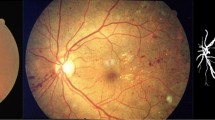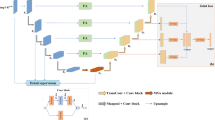Abstract
OCT-angiography is a non-invasive visualization imaging technology with high resolution that can more clearly image tiny blood vessels. Certain ophthalmic diseases can be diagnosed by the morphological changes of retinal blood vessels, and the automatic segmentation of blood vessel will definitely reduce workload of ophthalmologists. Current segmentation methods result in the loss of important detailed features and the segmenting failure of tiny blood vessels. We propose a joint 2D attention gate and channel-spatial attention network for the retinal vessel segmentation of OCT-angiography images to improve accuracy and reduce error rate. The improved 2D attention gate introduces attention coefficients to increase the weight of the blood vessel area, which preserves the branch structure and edge information of tiny blood vessels to a greater extent by combining context feature information of different levels of units. The channel-spatial attention block is used to enhance channel and spatial channel information, respectively. To enhance the credibility, our network was tested on two public data sets. Compared with channel and spatial attention network, U-Net with residual block and U-Net, the important indicator of accuracy is increased by 1.97%, 2.18% and 3.04%, respectively, in data set I and increased by 0.18%, 0.19% and 0.62%, respectively, in data set II.








Similar content being viewed by others
References
Kashani, A.H., et al.: Optical coherence tomography angiography: A comprehensive review of current methods and clinical applications. Prog. Retin. Eye Res. 60, 66–100 (2017)
Pujari, A., et al.: OCTA in neuro-ophthalmology: current clinical role and future perspectives. Surv. Ophthalmol. 66(3), 471 (2020). https://doi.org/10.1016/j.survophthal.2020.10.009
Sambhav, K., Grover, S., Chalam, K.V.: The application of optical coherence tomography angiography in retinal diseases. Surv. Ophthalmol. (2017). https://doi.org/10.1016/j.survophthal.2017.05.006
Laura Kuehlewein, B., A, et al.: Optical coherence tomography angiography of type 1 neovascularization in age-related macular degeneration. Am. J. Ophthalmol. 160(4), 739–748 (2015). https://doi.org/10.1016/j.ajo.2015.06.030
Hwang, T.S., et al.: Optical coherence tomography angiography features of diabetic retinopathy. Retina 35(11), 2371–2376 (2015)
Jia, Y., et al.: Optical coherence tomography angiography of optic disc perfusion in glaucoma. Ophthalmology 121(7), 1322–1332 (2014)
Yoon, S.P., et al.: Retinal microvascular and neurodegenerative changes in Alzheimer’s disease and mild cognitive impairment compared with control participants. Ophthalmol. Retina. 3(6), 489–499 (2019)
Y Ma et al (2020) ROSE: A Retinal OCT-Angiography Vessel Segmentation Dataset and New Model. In: IEEE Trans. Med. Imaging. 40(3): 928–939.
Raz F (2012) Blood vessel segmentation methodologies in retinal images – a survey. In: Comput Method Program Biomed. 108(1), 407–433 (2012) https://doi.org/10.1016/j.cmpb.2012.03.009.
Frangi, R.F., et al.: Multiscale vessel enhancement filtering. Lect. Notes Comput. Sci. 1496, 130–137 (1998)
Zhao, Y., et al.: Automatic 2D/3D vessel enhancement in multiple modality images using a weighted symmetry filter. IEEE Trans. Med. Imaging 37(2), 1–1 (2017)
Cetin, S., Unal, G. A higher-order tensor vessel tractography for segmentation of vascular structures. In: IEEE Trans. Med. Imaging. 34(1), 2172–2185, (2015).
N., Eladawi, et al.: Automatic blood vessels segmentation based on different retinal maps from OCTA scans. Comput Biol Med. 89, pp. 150–161, (2017)
S. S., Gao, et al.: Compensation for reflectance variation in flow index quantification by optical coherence tomography angiography. (2017)
Camino, A., et al.: Enhanced quantification of retinal perfusion by improved discrimination of blood flow from bulk motion signal in OCTA. Trans. Vision Sci. Technol (2018)
M. S. Sarabi, et al.: An automated 3D analysis framework for optical coherence tomography angiography. bioRxiv (2019). https://doi.org/10.1101/655175.
P. Liskowski, K. Krawiec.: Segmenting retinal blood vessels with deep neural networks. in IEEE Trans. Med. Imaging. 35, 2369–2380, (2016)
O. Ronneberger, P. Fischer, T. Brox.: U-Net: Convolutional networks for biomedical image segmentation. International conference on medical image computing and computer-assisted intervention, Springer, Cham, (2015)
L. Mou, et al.: CS-Net: Channel and spatial attention network for curvilinear structure segmentation. In: MICCAI, 721–730, (2019)
Li, M., et al.: Image projection network: 3D to 2D image segmentation in OCTA Images. In: IEEE Trans. Med. Imaging 99, (2020):1–1
Liang Z, Zhang J, An C.: Foveal avascular zone segmentation of octa images using deep learning approach with unsupervised vessel segmentation. In: ICASSP 2021 - 2021 IEEE International conference on acoustics, speech and signal processing (ICASSP). (2021)
O., Oktay, et al.: Attention U-Net: learning where to look for the pancreas. In: 1st Conference on medical imaging with deep learning, Amsterdam, The Netherlands, (2018)
S., Jetley, et al.: Learn to pay attention. In: International conference on learning representations. (2018)
Y., Giarratano, et al.: Automated segmentation of optical coherence tomography angiography images: Benchmark Data Clinic. Relevant Metrics. (2019)
Acknowledgements
This work is partially supported by the Natural Science Foundation of Shandong Province (No: ZR2020MF105), Guangdong Provincial Key Laboratory of Biomedical Optical Imaging Technology (No: 2020B121201010).
Author information
Authors and Affiliations
Corresponding author
Additional information
Publisher's Note
Springer Nature remains neutral with regard to jurisdictional claims in published maps and institutional affiliations.
Rights and permissions
Springer Nature or its licensor holds exclusive rights to this article under a publishing agreement with the author(s) or other rightsholder(s); author self-archiving of the accepted manuscript version of this article is solely governed by the terms of such publishing agreement and applicable law.
About this article
Cite this article
Cui, B., Qi, S., Meng, J. et al. Joint 2D attention gate and channel-spatial attention network for retinal vessel segmentation of OCT-angiography images. SIViP 17, 1219–1226 (2023). https://doi.org/10.1007/s11760-022-02329-6
Received:
Revised:
Accepted:
Published:
Issue Date:
DOI: https://doi.org/10.1007/s11760-022-02329-6




